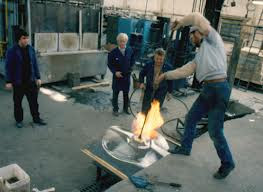Silica can be a primary constituent of most glass. It is true that some glasses are nonstoichiometric. However, silica does fall in line as being stoichiometric. This video is to help some of you who are taking chemistry in addition to physics. Several of you have asked for help with this type of problem, so I hope you enjoy it.
http://www.educreations.com/lesson/view/chemistry-help/7359762/?s=4B6vvu&ref=app
Saturday, April 27, 2013
Saturday, April 20, 2013
Lens Equation and Diverging Lens
Greetings gang! As we dive into Geometric Optics, I wanted to take a moment and reveal to you that my good friend Mr. Rick Sharpe bested me today. Mr. Sharpe of course is also participating in this project and has a very informative blog that I recommend you view. In our discussion, I was discussing the input and influence of Rene Descarte in optics; he is credited with the development of many of the equations and concepts we study in optics. I noted that Christian monks in Europe around 1000 C.E. were known to use quartz-type crystals to help in reading, thinking this to be the earliest group and time period for using such reading aides. Mr. Sharpe pointed out that magnifying lenses have been found in Viking settlements pre-dating the monks. Also, the Romans were known to have a "burning lense" made of a glass bowl and water used for magnification. I wonder just how far back we can trace the use of glass as a magnification tool.
I did promise to work a sample lens problem for you with a diverging lens. Interestingly, pretty much all lenses today are created from flint and/or crown glass which you should be familiar with from our general study of refraction. Enjoy the video.
http://www.educreations.com/lesson/view/lens-equation-diverging-lense/7114673/?s=ACK7eh&ref=app
I did promise to work a sample lens problem for you with a diverging lens. Interestingly, pretty much all lenses today are created from flint and/or crown glass which you should be familiar with from our general study of refraction. Enjoy the video.
http://www.educreations.com/lesson/view/lens-equation-diverging-lense/7114673/?s=ACK7eh&ref=app
Thursday, April 18, 2013
Williamstown: I have selected Williamstown, WV as my "Glass Town" for this project. As time goes by, I will be adding more information and updates to regarding Williamstown and our visit there this summer.
Williamstown has a population of roughly 2900 and is situated in Wood County, near the Parkersburg area. Williamstown is famous for Fenton glass which was established in 1905 by brothers Frank and John. At one time Fenton Glass produced more hand-crafted art glass than any other company in the US. In 1987, Fenton Glass established a unique relationship with QVC in which QVC marketed glass products only from Fenton Glass.
In, 2007 Fenton Glass suffered from financial problems and issued a closure statement. In response, QVC promoted their products and a frenzy of sales ensued. This allowed Fenton to remain open until 2011 when the company was forced to sale most of its assets. Nearly 400 people lost their jobs.
Today, Fenton Art Glass operates by designing beads and earrings.
Sunday, April 14, 2013
Apex Angle and Minimum Angle of Deviation
Here is a sample on Minimum Angle of Deviation for a Cubic Zirconia Prism. Interestingly, the author of the problem uses 1.34 as the prism's index of refraction; water, as we know, has an index of 1.33. Cubic Zirconia has an actual index of roughly 2.15. I would expect this is a multi-variation problem from Quest Learning. The application of the equation will work no matter what numbers are introduced. Enjoy!!
http://www.educreations.com/lesson/view/cubic-zirconia-prism/6874458/?s=coEI8E&ref=app
http://www.educreations.com/lesson/view/cubic-zirconia-prism/6874458/?s=coEI8E&ref=app
Total Internal Reflection: Flint Glass
Here is a quick video lesson on Total Internal Reflection as applied to Flint Glass.http://www.educreations.com/lesson/view/total-internal-reflection-flint-glass/6874434/?s=k2sbcw&ref=app
Monday, April 8, 2013
Sunday, April 7, 2013
Saturday, April 6, 2013
Welcome: Introductions
Greetings friends! My name is William Strait. I am presently a Science teacher at Huntington High School in Cabell County, West Virginia. The purpose of this blog is to help illustrate the impact of the glass and ceramic industries in conjunction with my content area. We will experience this adventure from a three-pronged approach: historical, social, and scientific. We will explore the historical nature of the glass industry in its various incarnations. We will address the social and economic impact of the industry through its evolution to present day. And, we will use the physics of glass to impart on students the real-life connection between the principles we learn in class to their true application.
To my Honor's Physics students, this blog will now serve as a primary source for the remainder of the semester. Edmodo will still be available, but now lessons and samples will be linked to this blog for your reference, as we develop our understanding of optics, fluids, and thermodynamics. Check back often for updates, and I encourage you all to take a look at my fellow teachers and their sites.
Mr. Strait
To my Honor's Physics students, this blog will now serve as a primary source for the remainder of the semester. Edmodo will still be available, but now lessons and samples will be linked to this blog for your reference, as we develop our understanding of optics, fluids, and thermodynamics. Check back often for updates, and I encourage you all to take a look at my fellow teachers and their sites.
Mr. Strait
Subscribe to:
Posts (Atom)



